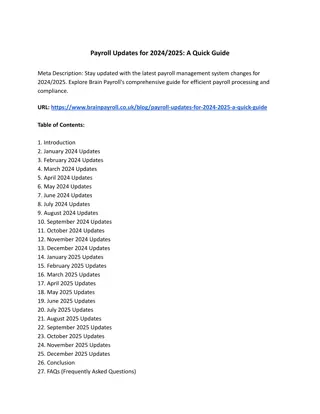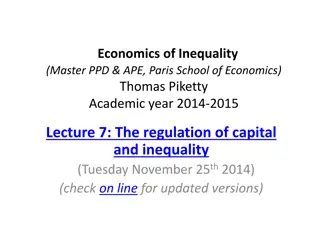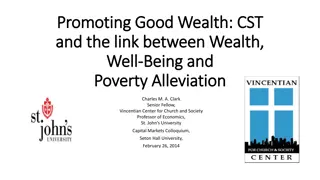Insights on Ukraine Payroll Tax Reforms and Wealth Disparities: Lessons from Bulgaria
Explore the dynamics of Ukraine's payroll tax reforms and wealth indicators in comparison with Bulgaria, examining historical contexts, welfare situations, and macroeconomic factors such as GDP per capita, debt levels, and employment rates. Insights into cost of living differentials, tax structures, and government size shed light on economic development in both countries.
Download Presentation

Please find below an Image/Link to download the presentation.
The content on the website is provided AS IS for your information and personal use only. It may not be sold, licensed, or shared on other websites without obtaining consent from the author.If you encounter any issues during the download, it is possible that the publisher has removed the file from their server.
You are allowed to download the files provided on this website for personal or commercial use, subject to the condition that they are used lawfully. All files are the property of their respective owners.
The content on the website is provided AS IS for your information and personal use only. It may not be sold, licensed, or shared on other websites without obtaining consent from the author.
E N D
Presentation Transcript
Ukraine payroll tax reforms: lessons from Bulgaria, other reformers and history Krassen Stanchev, Sofia University, chairman of IME (www.ime.bg) Board, and CEO of KC2 LTD 1 (stanchev@ime.bg) Economics of bizarre phenomena , Kyiv, December 20, 2021
2 - Some comparisons of welfare situations - Tax wedges in New Europe - The optimal size of government - History lessons from rich countries Themes , Kyiv, December 20, 2021
3 - The only country in Europe that in the 20thcentury managed to default 6 times on its government debt - An image of worst and poorest country in the EU - 20thcentury s 17thin the world hyperinflation (1996-1997), followed by a second edition of pro-market reforms - Since 2007-2008: 10% proportional tax of incomes, single rate (no non-taxable threshold) - In the last 10 years one of the only 3-4 EU member states fully (and almost steadily) compliant with the stability pact - The average size of government in the last 15 years 36-37% of GDP - Since 2011: fiscal rules of a) deficit of no more than 2% of GDP, b) debt of no more than 40% of GDP and c) general government spending of no more that 37% of GDP Why Bulgaria 7 reasons , Kyiv, December 20, 2021
4 2021 Bulgaria and Ukraine wealth and welfare, selected measures with focus on households , Kyiv, December 20, 2021
Sofia and Kyiv costs of living in 2021 (Q2) 5 Bulgaria Ukraine Difference (%) Mortgage rates, Sofia & Kyiv (%) 3,13 14,44 +358,35 Rent USD, 1 bedroom, not-in-downtown 338,06 390,66 +15,56 USD Monthly Wage, after tax (Sofia & Kyiv) 937,62 761,27 -18,81 Cost of Living Index (New York = 100) 41,36 34,80 15,86 USD price per 85 m2 for Electricity, Heating, Cooling, Water, Garbage (Sofia & Kyiv) 112,63 115,92 +2,92 , Kyiv, December 20, 2021
Some macro and wealth indicators 6 Bulgaria Ukraine Difference (%) USD ('000) GDP per Capita 2020 USD ('000) Debt per capita 2020 Youth Unemployment %, 2021 (Q2) Employment rate 20-64 - 2021 (Q3) Unemployment rate, 2021 (Q3) 10,01 3,74 267,47 2,5 2,28 15,5 21,40 38,00 72,1 64,60 10,40 4,60 9,30 Wealth USD ('000) 2019 42686,00 8792,00 485,51 Wealth growth rate 2000- 2019 (%) 1111,90 1005,00 9,61 Life expectancy (2019) 75,5 years 72,1 years Fertility Rate (2021) 1,6 1,30 , Kyiv, December 20, 2021
Last 20 years of wealth dynamics, Bulgaria and Ukraine 7 The growth rate, for both countries, is very high in European context The difference, perhaps, comes from: a) the starting point b) overall simplicity of Bulgaria's tax system, which incentivizes compliance c) fiscal discipline d) Bulgaria s globally lead position in FDI index in 2006-2008 Re compliance: by 2019, Bulgaria was the only EU country in which multi-national companies fully complied with the tax law see: Petr Jansky, Effective Tax Rates of Multinational Enterprises in the EU Bulgaria Ukraine % 2000 2019 % change 2000 2019 change 1005,95 % 3,839 42,686 1111,90% 874 8792 , Kyiv, December 20, 2021
General government spending since 2010 8 Ukraine Bulgaria Year % of GDP Per capita (USD) % of GDP Per capita (USD) 2020 45.99 1,728 41.8 4234 2019 41.35 1,526 35.5 3519 2018 41.72 1,302 36.9 3504 2017 41.59 1,107 34.8 2927 2016 40.56 893 34.8 2642 2015 43.04 915 40.4 2868 2014 44.77 1,369 43.20 3426 2010 49.15 1,468 36.1 2488 , Kyiv, December 20, 2021
Some interim conclusions (and links) 9 On Costs of living: NUMBEO - https://www.numbeo.com/cost-of- living/compare_cities.jsp?country1=Bulgaria&cit y1=Sofia&country2=Ukraine&city2=Kiev+%28Kyiv %29&amount=4%2C100.00&displayCurrency=US D UKRAINE In 2020 the highest general government spending as % of GDP since 2014 In per capita terms, the government spending had grown up by 47% - this fact may motivate tax non-compliance by individuals and households On Ukraine s General government expenditure: CountryEconomy.com (based on IMF data) - https://countryeconomy.com/government/exp enditure/ukraine On wealth (all assets per adult): Credit Suisse Research Institute, Global wealth databook 2019 - https://www.credit- suisse.com/media/assets/corporate/docs/about -us/research/publications/global-wealth- databook-2019.pdf Bulgaria is doing better on almost all indicators with smaller government The tax system demonstrated robustness in 2009-2010 and 2020 recessions FLAT TAX IN BULGARIA: History, Introduction, Results, Sofia, IME, 2016 - https://ime.bg/var//The-Flat-Tax-in-Bulgaria.pdf , Kyiv, December 20, 2021
10 Same or similar lessons from other countries , Kyiv, December 20, 2021
New Europe countries general government spending in the years associated with 2009 recession 11 Only Hungary and ex-Yugoslav Slovenia and Croatia have had persistently high (above 45% of GDP) levels of expenditure Slovenia holds the record high general government expenditures in 2013 - 54.9% of GDP, to deal with bank and SOE debts. (SOE debts are typically not counted as government spending.) Only in 2009 2014 the average NE government expenditures were above 40%, reaching the highest point of 43.5% in 2009 and then were gradually reduced to below 40% of GDP (37.7% in 2015). Five countries (Bulgaria, Estonia, Latvia, Lithuania and Romania) almost never passed the level of 40% of GDP, and most often kept their expenditures between 37 and 38%. This philosophy of public finances is very simple: countries should first become rich before government embark of redistribution path. , Kyiv, December 20, 2021
These two patterns of public finance are well demonstrated by the countries selected for the following chart: Bulgaria and Romania (and the Baltics) maintain relatively low levels government expenditures to GDP 12 General Government expenditures as percent of GDP, before and after 2009 recession 46.00 44.00 42.00 Percent of GDP 40.00 38.00 36.00 34.00 32.00 30.00 2006 2007 2008 2009 2010 2011 2012 2013 2014 2015 2016 Bulgaria Czech Republic Romania , Kyiv, December 20, 2021
Same pattern is to be observed in some FSU and EAEU countries 13 General government expenditures before and after 2009 recession in select FSU countries (as % of GDP) 55.00 50.00 45.00 Percent of GDP 40.00 35.00 30.00 25.00 20.00 15.00 2006 2007 2008 2009 2010 2011 2012 2013 2014 2015 2016 Armenia Georgia Moldova Ukraine , Kyiv, December 20, 2021
Tax wedges (TW) in new Europe members of OECD 14 In all OECD countries the trends is towards shrinking, from about 36.5% in 2000 to 35% in 2020 More sharp the trends is in Estonia from 41 to 36.9%, Hungary from almost 55 to 43.6%, and Lithuania from 45.7% to 36.9% In Slovakia, when the introduced the flat tax the TW dropped down from almost 43 to 36.9%, after the repealed the flat tax, the trend is up to 41.8% in 2020. The TW did not registered a firm trend in Czechia, Latvia and Poland. All NE countries are currently with higher TW rates than OECD average. In Bulgaria, the trend is similar: from 40 to 34.5% for the same period but since 2001 is persistently below the OECD average. , Kyiv, December 20, 2021
15 Taxpayers incentives to work and contribute to social welfare Sub-themes and hypothesis - The system should set incentives to work and comply - The household perspective is key, the welfare system should take into account at least two factors the costs of living and in-family redistribution of welfare (the so called family contribution to actual social welfare) - Ukraine ex-Communist neighbors are reducing the tax wedges, increasing the after tax income - Rich countries had no large tax redistribution when they were poorer, and still have relatively low levels of tax wedges , Kyiv, December 20, 2021
Gross average wage dynamics 16 , Kyiv, December 20, 2021
Distribution of total income in Ukraine in 2020, by decile group 17 Source on 2019 2020 Hrynvia income change: https://www.statista.com/statistics/1 264392/ukraine-population- distribution-by-monthly-per-capita- money-income/ Source on shares of total income: https://www.statista.com/statistics/1 264567/ukraine-income-distribution- by-decile-group/ The income inequality does not necessitates different tax treatment of income groups In 2020, ~22% of Ukrainians had an average monthly income between UAH 4 and 5,000. Residents with a monthly income below UAH 3,000 represented over 8% (2.4% lower than in 2019) A bit more than 3% earned more than UAH 12,000 10% of Ukrainians with the highest- earning received almost 22% of the total income in the country in 2020. Earnings of the decile with the lowest income got 4.4%. , Kyiv, December 20, 2021
Ukraine's Household Income per Capita from 1999 to 2020 in the chart 18 , Kyiv, December 20, 2021
Household perspective is key 19 In real life macroeconomic and welfare indicators are subject to the rule that taxpayers do not hate taxes, only the act of paying them . Based on this fact every tax reform idea is tempted to convince the public at large that someone else will be paying the new tax. Macroeconomics is not even a footnote in motivations that determine individual choices Ukraine is demographically (household size, fertility rate) and culturally similar to Bulgaria. I failed to find data for Ukraine on intergenerational distribution and family contribution to welfare (FCW), so I us the analogy with Bulgaria. FCW in Bulgaria is 25-30% of the gross taxable income, in difficult years is goes down to 20%, this means that for 2020 the following is valid: Cash EURO bln 5,80 7,50 9,00 % FCW 20 25 30 % of GDP 4,80% 6,10% 7,90% , Kyiv, December 20, 2021
20 When rich countries were about to become rich, they had low levels of general government expenditures as % of GDP, and no progressive taxation , Kyiv, December 20, 2021
Leszek Balcerowicz: Berlin, Federal Ministry of Finance, December 7, 2011 21 The Process and Facts: Spending - Taxes - Deficit (surplus) - Explicit Public Debt Spending is the key driver; especially the social transfers Figure 1. General government spending as % of GDP Source: Tanzi V., Schuknecht L. (2000), Public spending in 20th century, Cambridge University Press ; World Economic Database Figure 2. Social spending (in-kind and in-cash spending) as % of GDP 1913 1920 1937 1960 1980 1990 2000 2007 17,0 14,8 17,1 12,7 7,5 27,6 25,0 30,1 26,2 12,1 29,0 34,1 31,1 30,0 19,7 34,6 32,4 30,1 32,2 27,0 46,1 47,9 42,1 43,0 31,4 49,8 45,1 53,4 39,9 32,8 51,6 45,1 46,2 39,0 34,5 52,3 43,6 47,9 44,2 36,6 France Germany Italy UK USA Source: Master theses on welfare state dynamics by: Magda Ci kowicz, Jaros aw Kantorowicz,Piotr P ka a, Wiktor Rak , Seweryn Szwarocki 1913 1920 1937 1960 1980 1990 2000 2007 1,2 3,7 13,7 21,1 16,4 15,3 9,7 26,1 30,4 25,4 22,9 18,1 29,3 27,6 28,4 24,7 18,4 32,0 31,8 29,6 26,3 19,6 32,0 28,9 31,5* 29,9 21,4 France Germany Italy UK USA 2,2 7,1 3,3 10,5 8,6 , Kyiv, December 20, 2021
Lessons from G-7 and OECD members 22 a. In most of them income taxes and especially progressive tax systems were imposed to finance wars or under the pretense of financing post-war recovery. b. In these countries, progressive tax systems remained relatively unchanged after 1920. But in 1920, these countries were on average four times richer in GDP per capita than, for example, Eastern European countries and six-seven times richer than the rest of the world. c. More important, however, is capital formation: higher taxes will diminish its pace. According to Credit Swiss latest Global Wealth Report (where wealth is measured according to the market prices of the assets owned by governments, corporations and adult individuals), in 2019 North America is 27 times wealthier than Africa (where the growth rate is 14% a year), 1.5 times richer compared to China, and 7.8 times better than India. Europe s wealth is 76.1% of that of North America. Higher taxes will have a negative impact on capital formation in less affluent part of the globe. C1) Bulgaria is about 3 times less wealthy that Europe on average d. Except for China, G-7 countries are the ultimate creditor of the rest of the world: their proposal is likely to make other countries more dependent on aid and credit from G-7, Europe and China. e. Today, old OECD members is more than three times richer than the world average, the average values of GDP per capita in of the world countries are comparable to those before the introduction of corporate, subsistence and progressive taxation in the G-7. In other words, these countries are effectively denied the growth opportunity the richest countries enjoyed when they were less prosperous. , Kyiv, December 20, 2021
The larger picture: government dents are high, corporate tax revenue declining and insignificant 23 , Kyiv, December 20, 2021
Conclusions 24 The reform of the income/payroll taxation should take into account systemic and incentives-related realities that are not yet well visible. Most important is to realize what in Ukraine is the intergenerational, within family distribution of income and family contribution to welfare (FCW). Almost equally important is to take into consideration the trends in payroll taxes in OECD and new OECD member states. Higher wages and payroll taxes are associated with all sources of family income, not only taxes on labor. In other words overall wealth levels of the adults in a country must be an integral part of the occasion. This also means the corporate income tax shall be reformed, typically corporate tax revenue to state budgets has a significant share in economies with huge state ownership, e.g. Cuba. The overall direction of the payroll tax reform shall be towards simplification and equal treatment of different categories of tax payers. , Kyiv, December 20, 2021























